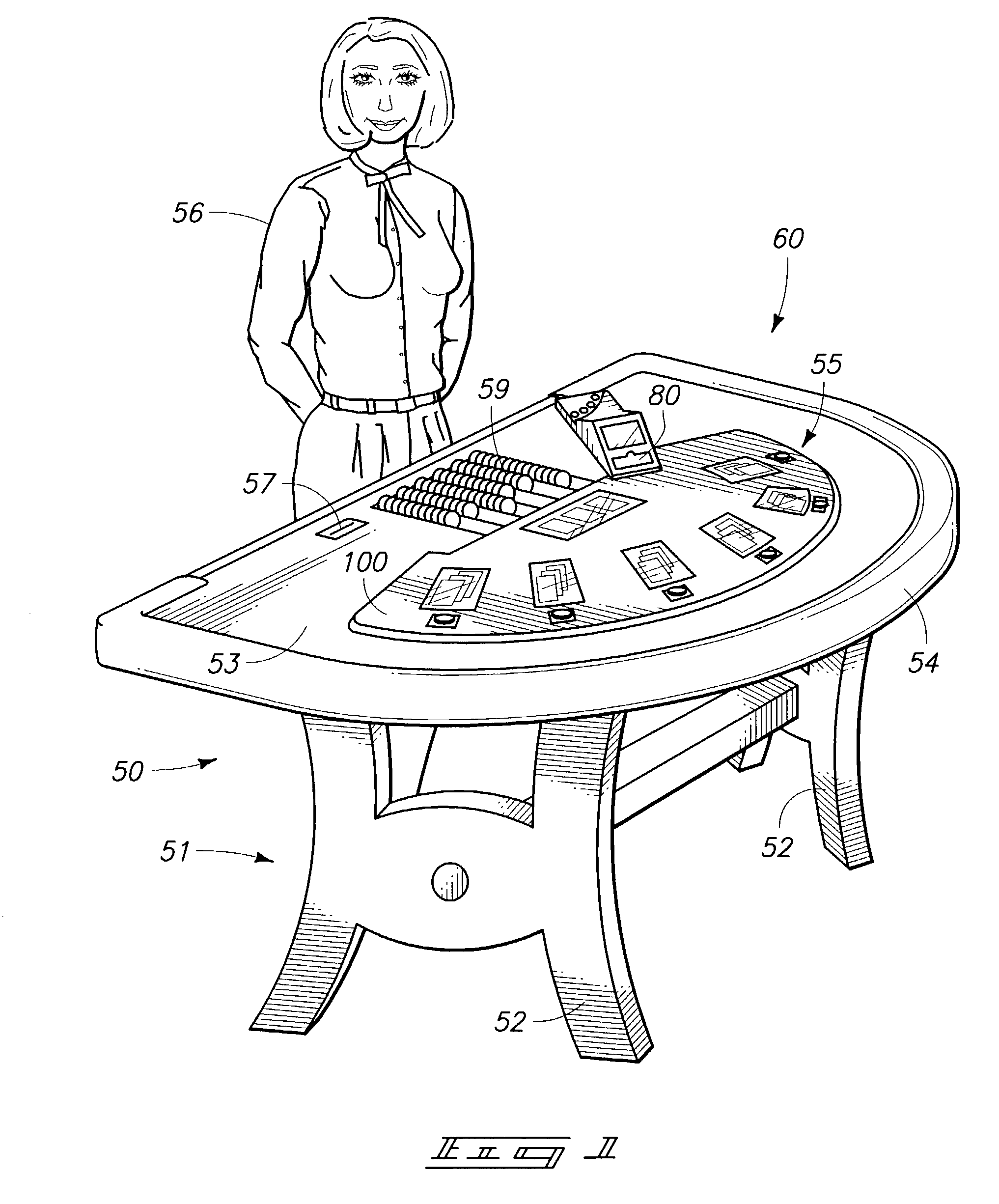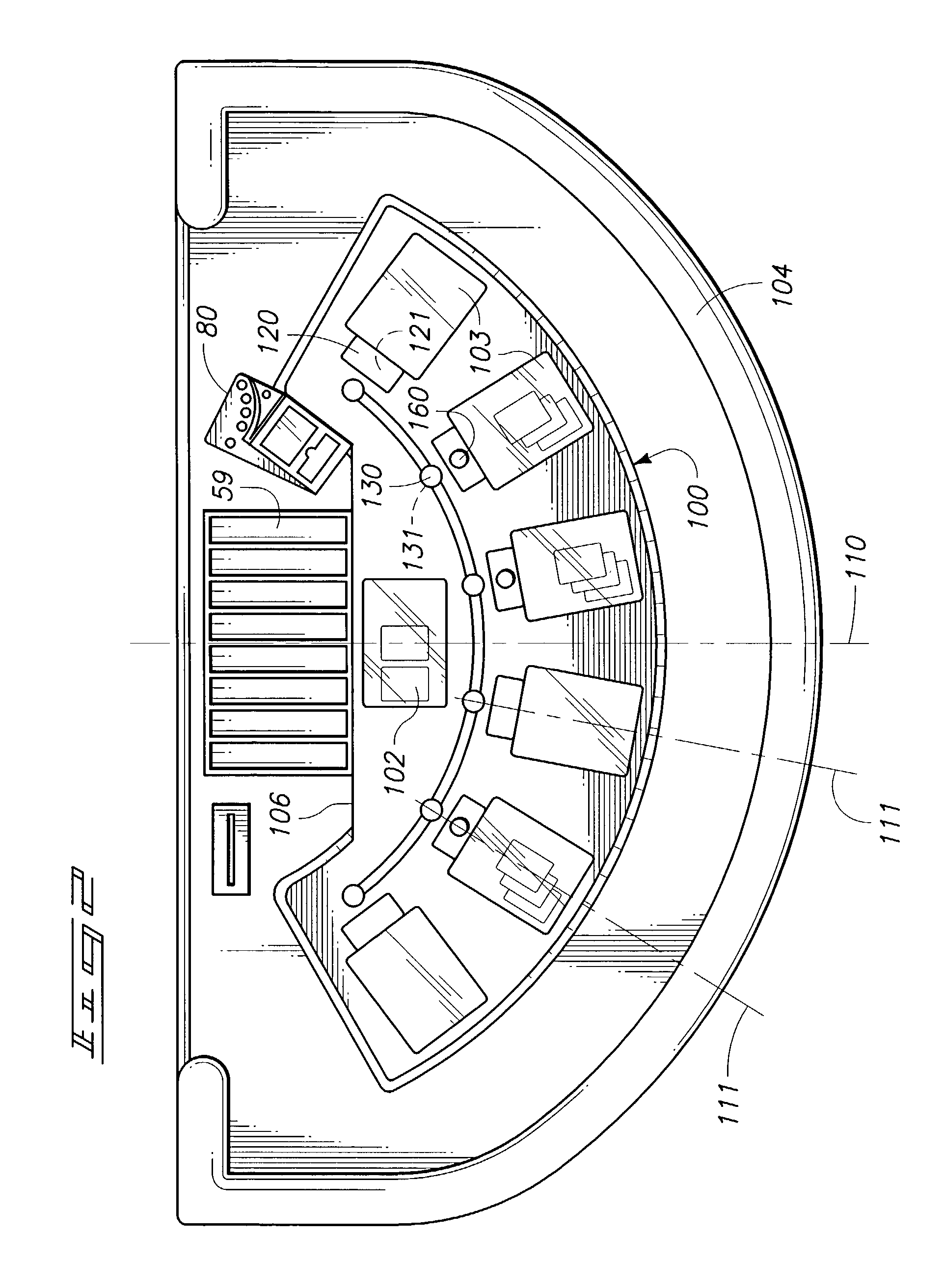The use of playing cards has a number of associated limitations and disadvantages which have long plagued the casino industry.
Others are problems associated with the use of playing cards in particular games.
The use of playing cards at live table games typically involves several
operational requirements which are time-consuming.
These manipulations take time and are not typically appreciated by either the dealer or players as enhancing the play and entertainment value of the game.
When
shuffling is needed, it involves a break in the action of the table game and consumes a significant amount of time.
Thus, earnings are limited by the number of hands that can be played per hour.
Accomplishing this without detracting from the players enjoyment and desire to play the game is a challenging and longstanding issue with casino owners and consultants in the gaming industry.
Shuffling machines currently available have costs in the thousands of dollars.
Such machines save time in performing the
shuffling process, but still require time to load, operate and unload.
These factors reduce the savings associated with reduced
shuffling time and effort.
The amount of time consumed by collecting, shuffling and dealing is also of significance in private card games because it also delays action and requires some special effort to perform.
In private games there is also some added complexity due to card players remembering or figuring out who previously dealt and who should now shuffle and re-deal the cards as needed.
In addition to the time
delay and added activity needed to collect, shuffle and deal cards, there is typically some time devoted to
cutting the
deck of cards which have been shuffled and which are soon to be dealt.
Although
cutting the
deck does not require a large amount of time, it does take some time.
The above and related considerations clearly demonstrate that a substantial amount of time is consumed by collecting, shuffling, cutting and dealing playing cards.
In the gaming industry there is also a very significant amount of time and effort devoted to security issues which relate to play of the casino games.
Part of the security concerns stem from frequent attempts to cheat during play of the games.
The amount of
cheating in card games is significant to the casino industry and constitutes a major security problem which has large associated losses.
The costs of efforts to deter or prevent
cheating are very large and made on a daily basis.
This approach is disadvantaged by the fact that not all cards dealt are easily known from a camera position above the table because some or all of the cards are not dealt face-up, or are hidden by overlying cards.
Although many blackjack games are sufficiently revealing to later determine the order of dealt cards, others are not.
The covered cards of the players do not allow the order of dealt cards to be ascertained from an above-table camera.
Even where above-table cameras are used, their use may not be effective.
Such cameras may require time-consuming and tedious human analysis to go over the video tapes or other recordings of table action.
Such human analysis is costly and cannot economically be used to routinely monitor all action in a casino cardroom.
It is also required because there is no current way for easily ascertaining whether the dealer or player won the hand, such as in a blackjack game.
It is typically not possible to discern the indicia number or letter presented in the corner of the
playing card when viewed in a recorded
video tape.
Counting the individual pips in the center field of the playing cards can be done; however, it cannot be done in all situations with the desired reliability.
This is true because cards may be partly or totally covered by another overlying card contained in the same hand, leading to missing information or mistaken interpretations.
For the above reasons, the
video camera monitoring techniques have only found very limited effectiveness as a routine approach for identifying cheating.
There has also been relatively limited use as a serious analytical tool because of the difficulty of analysis.
Such camera surveillance techniques are also of only limited effectiveness as a deterrent because many of the people involved with cheating have a working knowledge of their limitations and utilize approaches which are not easily detectible by such systems.
More routine and
general screening to detect cheating has remained a difficult and continuing problem for casinos.
This increases the cost of the cards and may not fully resolve the problems and difficulties in obtaining accurate information concerning sequence information.
The
automated data collecting card shoes also do not have an inherent means for collecting data on the assignment of the card to a particular player or the dealer.
They further do not collect data on the amounts bet.
An additional issue which has continued to be a concern in the casino industry relates to the use of automated shuffling machines.
Prior automated shuffling machines have not demonstrated a sufficient ability to thwart
highly skilled gamblers.
Prior card shuffling machines all show a
weakness in that skilled gamblers can observe operation of the machines and in many situations make predictions which serve as a means for card tracking.
However, it has been found that multiple decks are not sufficient to overcome the skilled gambler's ability to track cards and turn the
advantage against the house.
Sequential card tracking can be devastating to a casino since a player taking
advantage of such information can bet large in a winning situation and change the
odds in favor of the player and against the casino.
There is also a long-standing problem in the play of blackjack which concerns the situation when the dealer receives a blackjack hand in the initial two cards dealt.
If the hand is fully played out, and the dealer then reveals that the dealer has received a blackjack hand, then a significant amount of time has been wasted.
It also causes players to often be upset when a hand is played out to no avail.
Because of this potential for cheating, peeking as a normal procedure in the play of blackjack has been viewed with disfavor by many casinos.
Some casinos which have experienced losses due to such cheating have eliminated the peeking procedure and decided to instead incur the waste of time and problems associated with playing out the hand of cards.
These devices and methods generally add greater costs and slow the play of the game.
The prior attempts have often ended up unacceptable and are removed.
This problem has nagged the casino industry for many years and a fully acceptable solution has never been found.
Another notable problem suffered by live table games is the intimidation which many novice or less experienced players feel when playing such games.
These people feel intimidation at a live table game because such games require quick thinking and
decision making while other people are watching and waiting.
Since betting at live table games is generally larger, this development is something of a
disadvantage to the casinos as compared to the same persons participating in a live table game.
Efforts to stem or reverse this trend using
specialty table games with different play and larger jackpots have not been effective or of only temporary beneficial effect.
Some of the efforts have produced fads or other temporary increases in interest levels but the overall effect has not had a long-term benefit.
A further issue which has developed in the casino business is the public's increasing interest in participating in games which have a very large potential payoff.
These
slot machine systems are relatively more costly to purchase and operate.
For many gamblers, this approach is not particularly attractive.
This lack of attractiveness may be due to the impersonal and solitary nature of playing slot machines.
Table card games have not been able to satisfactorily address this interest.
A further problem associated with live table card games are the costs associated with
purchasing, handling and disposal of paper and plastic playing cards.
In any case, the cost of playing cards for a casino is significant and can easily run in the hundreds of thousands of dollars per year.
In addition to the above problems, there are also a significant cost associated with handling and storing the new and worn playing cards.
Thus, the high costs of casino facilities further exacerbates the costs associated with paper and plastic playing cards.
 Login to View More
Login to View More  Login to View More
Login to View More 


